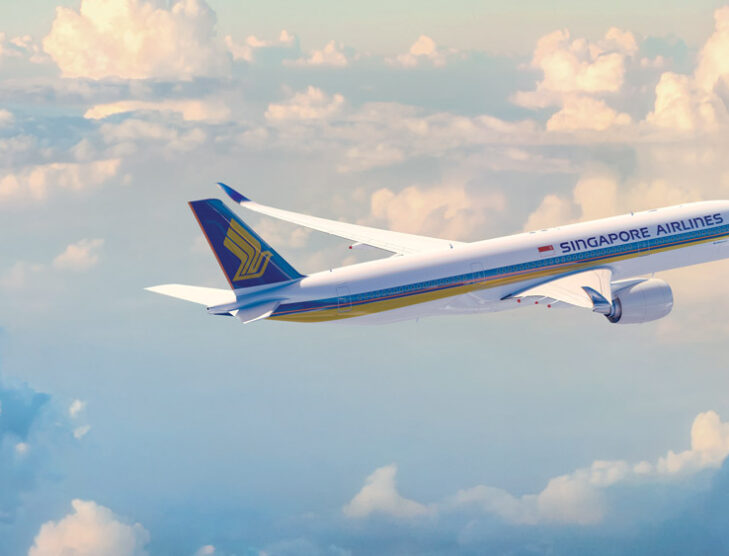
Is this the future of air travel?
Are we finally witnessing the end of those niggly intermediate stopovers or tiresome connecting flights changes while en route to a single destination? No more shuffling back and forwards between the bookshop and the pharmacy, unable to leave the airport wary of falling foul of customs, and unable to sleep for fear of missing the next leg of your journey.
One of the emerging trends in aviation is a move to longer haul flights. On 11 October 2018, Singapore Airlines introduced the world’s longest non-stop commercial passenger flight from Singapore to New York, covering a whopping 16,800 kilometres (km) from Changi airport to New York’s Newark International Airport. The flight time is an eye-watering 18 hours and 45 minutes. Singapore Airlines is offering a daily service, taking advantage of their first-mover status on the new A350-900 ULR (ultra long range) aircraft.
Not to be outdone, other aircraft operators have been quick to follow suit. Philippine Airlines (PAL) has replaced several intermediate stopovers and connecting flights in Canada, the United States West Coast and other Asian Countries with the introduction of a direct nonstop service from John F. Kennedy International Airport in New York, to the Philippines. Again, the operator is utilising the Airbus A350-900’s long-haul travel capability.
PAL has signalled that the new Manila-New York journey will be marked by “comfort, convenience and efficiency,” with PAL Vice President of Sales Ryan Uy noting brisk sales for their newest product offering. Qantas is another considering the merits of long-haul travel. In June 2018, CEO Alan Joyce declared they were considering an order for ultra-long jets that would allow Sydney to London flights and close the “tyranny of distance” between Australia and global financial hubs, such as London.
Before we get too excited, we’ve seen this all before haven’t we? The announcements certainly have a sense of deja vu.
A decade ago ultra-long-haul flights were common, before disappearing due to skyrocketing global oil prices and, importantly, a lack of demand. After all, 18 hours at 30,000 feet in the sky seems a very long time. Airlines are promising increased comfort to satisfy consumer demand in ultra-long haul – including quieter cabins, special LED mood lighting, a more intimate in-flight experience that helps adjust to time zones and time of day variances and, the kicker, affordable Wi-Fi for passengers.
Singapore Airlines was one of those that established and then phased out similar long-haul product offerings. What makes them think it will work this time around? And is long-haul really the future of travel, or simply a niche option for certain travellers or business people?
Vanessa Boag, general manager at Shell Aviation Lubricants, believes passengers can expect more direct flights over longer distances in the coming years. Shell operates one of the most extensive refuelling networks in the world, which includes around 850 airports across 32 countries. Boag is responsible for Shell Aviation’s comprehensive aviation lubricants portfolio.

The return of ultra-long-haul flights has in large part been enabled by next generation efficient aircraft which are suited to this length of flight, says Boag, such as the new Boeing 787 Dreamliner and Airbus A350 XWB models. The four engine Airbus A340, previously employed for the long-haul Singapore to New York leg, was significantly heavier and less suitable for a high-fuel environment. The new breed of aircraft is lighter, has faster cruising speeds, larger twin engines with better propulsive efficiency generated by fewer lighter blades, and more efficient fuel usage. These features enable cost effective, point-to-point direct flights over longer distances.
Certainly, the technology is impressive, and unlocks a world of opportunities for long haul travel. However, what is little discussed, says Boag, are the challenges that airlines and lubricant formulators face as result of these longer journeys.
Higher engine temperatures resulting from ultra-long-haul travel can have a huge impact on the costs associated with maintaining a safe and healthy fleet of aircraft. Higher temperatures can increase the temperature of the turbine engine oil (TEO), potentially resulting in unwanted and costly carbon deposits in the engine, a process otherwise known as coking, says Boag. This can necessitate more frequent engine overhauls, which can cost airlines upwards of USD200,000, she says. At a time when jet fuel is increasing in price, and airlines are searching for cost reduction initiatives, creating savings in maintenance and engine overhaul is imperative.
“The right TEO is one of the most effective, yet simple, ways for airlines to handle the maintenance pressure of ultra-long-haul flight on their engines,” says Boag, advocating for high thermal stability or high-performance capability oils that provide long-term thermal and oxidative stability. Anti-coking and high load carrying aviation lubricants can reduce in-service maintenance burden and increase aircraft utilisation, she says.
The Shell Group spends an average of USD1 billion in research and development every year and maintains a dedicated team of aviation scientists working on fuel quality, alternative fuels and lubricants.
AeroShell ASTO 560 TEO is specifically designed to handle higher engine temperatures and longer operations, says Boag. By way of example, the use of AeroShell ASTO 560 for PT6 engines operated by a large U.S.-based Pilatus PC 12 operator can extend the time between overhaul from 3,000 to 5,500 hours when combined with other good maintenance practices, she says. Boag estimates an overall saving of more than USD50 per engine flying hour.
A shift to ultra-long-haul flights also requires more fuel, creating further issues from the perspective of sustainability. The move “highlights the importance of progressing the transition to a lower carbon future for the aviation industry through the use of sustainable aviation fuels (SAF),” says Boag.
Boag emphasises Shell’s efforts to enable airlines and airport partners to integrate SAFs with significantly lower lifecycle carbon emissions into their operations. Actions including strategic collaborations with airlines KLM Royal Dutch Airlines, SAS – Scandinavian Airlines, Finnair, All Nippon Airways (ANA) and Japan Airlines to reduce carbon emissions at San Francisco International Airport (SFO), through the use of SAF derived from used cooking oil.







